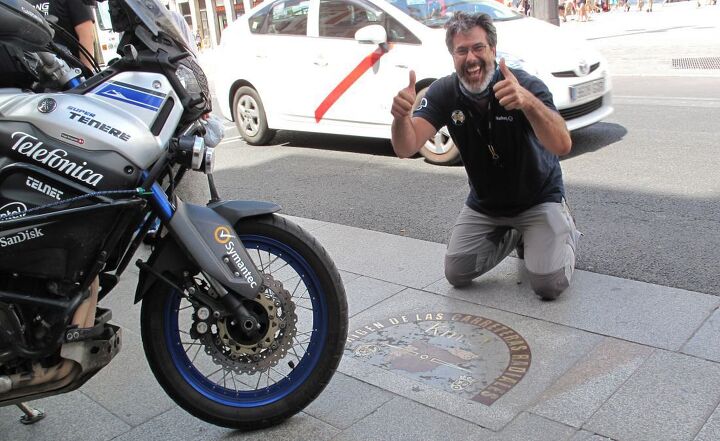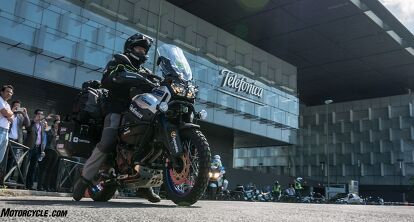Telefo`nica Yamaha Globalrider Concludes Successfully
– Hugo Scagnetti travelled through 13 countries in Europe, Asia, and America; a total of 37,000 kilometres on board his totally connected Yamaha Super Ténéré XT1200Z
– The solidarity aspect of the project, whose purpose was to raise funds for research into the treatment of avascular necrosis with stem cells, continues on the project‘s website www.telefonicayamaha.globalrider.org
– Scagnetti also fulfilled the technological objectives of the adventure by testing different Internet of Things (IoT) technologies, proving how they can help a pilot and his machine to respond to extreme situations better
The Telefónica Yamaha Globalrider solidarity adventure, the first journey around the world alone on a connected motorcycle, has concluded successfully. Hugo Scagnetti has made his motto “moving forward is the only way to come back” come true, arriving back to Madrid after travelling 37,000 kilometres through 13 different countries in Europe, Asia, and America (see HERE the press release issued from Jerez de la Frontera on 21st April 2016, following the launch of the Telefónica Yamaha Globalrider project).
The purpose of the trip was to raise funds for research into in the treatment of avascular necrosis with stem cells in the Haematology Service of the Puerta de Hierro Hospital and the Traumatology Service of the La Paz Hospital of Madrid.
Scagnetti finished the journey having met all the originally established objectives for both the solidarity aspect of the project, which continues despite the journey having ended on the www.telefonicayamaha.globalrider.org website where economic donations to the research can to be made, and the technological aspect of the project with Hugo having had the chance to experience innovative technologies applied to the motoring world for the first time, technologies that will be of great use to that industry.
In addition to the motorcycle trip itself, the pilot crossed the Adriatic Sea, the Caspian Sea, and the Sea of Japan by ferry, and the Pacific Ocean – between Seoul and San Francisco – and the Atlantic Ocean – between Toronto and Paris – by airplane transmitting everything from the exterior temperature to the tire pressure to his own mood in real time thanks to a pioneering combination of IoT, Cloud, and M2M technologies that made it possible to study both his behaviour and that of his machine, and to remotely monitor the entire journey.
Hugo had to make important, on the fly decisions such as rectifying the established route so as to avoid areas of conflict. For example, he decided to go around the Black Sea as soon as he left Istanbul en route to Capadocia considering the terrorist attack that had just struck the Turkish capital, thus avoiding some originally planned cities as a precautionary measure. Similarly, he also rectified his route through the United States where, in the end, he decided to travel through the northern part of the country until reaching Canada in order to make the Atlantic crossing quicker under the special program “flight with your bike”. In this way, he was able to complete that portion of the trip in less than ten hours, continue travelling through France the following morning, and arrive in Brittany where his family was waiting for him.
The role of technology
Telefónica technology played a fundamental role in this journey because both the motorcycle and the pilot wore “machine to machine” (m2m) and “Internet of Things” (IoT) technology, making it possible to generate and gather information regarding geolocalization, acceleration, gasses, temperature, tire pressure, inclination, probable falls, and even Hugo‘s physical condition and mood in real time so that a team of individuals could remotely control and aide Scagnetti and guarantee his security as much as possible.
Hugo had a button that kept him connected at all times and that proved to work in different risk situations, not just because he could push it in case of need but also because the system itself detected abnormal telemetric situations, such as in the two occasions where he fell off the motorcycle.
The pilot‘s skill, the motorcycle‘s precision, and the technology made it possible for Hugo to cross Spain, France, Italy, Greece, Turkey, Georgia, Kazakhstan, Azerbaijan, Uzbekistan, Russia, South Korea, the United States, and Canada, 1200 kilometres of deserts, and to support temperatures of up to 47 degrees with hardly any incidents and only two technical checks in Istanbul and San Francisco.
The reliability of the Super Ténéré XT1200Z was essential for Scagnetti, as was his complete confidence in the machine. This because it responded at all times despite the heavy load it carried (a load of nearly 400 kilos), even in the most extreme situations, like in Uzbekistan where he travelled through 800 kilometres of roads full of potholes that turned into pools of water when it rained.
Supporting research
Telefónica Yamaha Globalrider was born thanks to the promise made by Hugo Scagnetti after suffering avascular necrosis to the femoral head. He promised himself that if he was able to walk again he would travel around the world on motorcycle and produce a TV documentary to raise funds for the scientific research being conducted in the field of regenerative medicine with stem cells for children and young adults.
Hugo said “I wanted to prove that a person could travel around the world on motorcycle after suffering a serious health issue and raise funds to keep developing technology that can improve the life of many people who suffer the same illness I do”.
Telefónica Yamaha Globalrider was made possible thanks to the sponsorship of Telefónica and Yamaha; the support of partners like Beesion, Cisco, Intel, Mapfre, Rukka, Sandisk, SW-Motech, Symantec, or Telnet Ri; and the collaboration of Acens, Asus, CartoDB, Dynamic Line, Garmin, Iberia, Last Lap, Michelin, Parrot, Pegatin, Pléyade, Redverz, Sociograph Neuromarketing, and Thethings.iO.
The next step is the production of a documentary series for Movistar+ which will highlight the value of contact with other peoples and cultures through history, music, personal experiences, and the use of technology. Funds from the distribution rights of this documentary will go directly to the research teams of the Haematology Service of the Puerta de Hierro Hospital and the Traumatology Service of the La Paz Hospital in Madrid. Both institutions are working together in the treatment of avascular necrosis with stem cells.
More by Press Release




































Comments
Join the conversation